Acquisitions include:
- The “Bell film” documenting President Kennedy’s motorcade in Dealey Plaza
- Dallas native Jack Daniel’s camera and home movie taken in the immediate aftermath of the assassination
- Jacqueline Kennedy’s handwritten letters to John Steinbeck urging him to author President Kennedy’s post-humous biography
- Robert McClelland’s blood-soaked shirt worn while trying to resuscitate the President
- A 1961 handwritten letter from Lee Harvey Oswald sent from the USSR that illuminates his mindset while trying to return to the United States
Dallas, Texas, May 8, 2023—The Sixth Floor Museum at Dealey Plaza, the only museum dedicated to the history of the assassination of President John F. Kennedy, has announced notable additions to the collection that paint a vivid picture of the historic events of November 22, 1963, its aftermath, and enduring legacy. Highlights include footage of President Kennedy’s Dallas visit known as the “Bell film,” which together with existing holdings, provides The Sixth Floor Museum with a detailed photographic record of the Kennedy motorcade in Dealey Plaza; the newly acquired Jack Daniel Collection, including Daniel’s camera and ten-seconds of footage capturing the immediate aftermath of the President’s assassination, the only known movie taken from the West side of the Triple Underpass; handwritten letters from Jacqueline Kennedy to author John Steinbeck imploring that he write the authorized biography of her late husband; a bloodied shirt worn by surgeon Dr. Robert McClelland, who was inside Trauma Room One after President Kennedy was rushed to Parkland Memorial Hospital; and finally, a handwritten letter from Lee Harvey Oswald to his brother, Robert Oswald, sent from Minsk, USSR, expressing hope but uncertainty in advance of his return to the United States.
The addition of these holdings advances the Museum’s mission of preserving the memory of President Kennedy’s assassination, an American tragedy that is fundamental for understanding the nation’s ethos in the post-Kennedy era and beyond. In tandem with these acquisitions, the Museum has made available online nearly 500 complete oral history recordings (adding more every month) from its extensive and ever-growing repository of statements by eyewitnesses and key figures. These candid, informal interviews offer unique personal insight into that turbulent decade and the local—and global—impact of the Kennedy assassination. To date, the Oral History Collection includes more than 2,400 recordings.
“As stewards of the very location where the sniper’s perch was discovered, The Sixth Floor Museum provides a direct and powerful connection to a watershed moment in American history,” said Nicola Longford, Chief Executive Officer of The Sixth Floor Museum. “More so than any textbook, these incredible additions to our collection transport audiences by painting a vibrant picture of how President Kennedy’s death unfolded, enabling current and future generations to gain a fuller, more nuanced understanding of one of the most defining events of the 20th century.”
Acquisition highlights include:
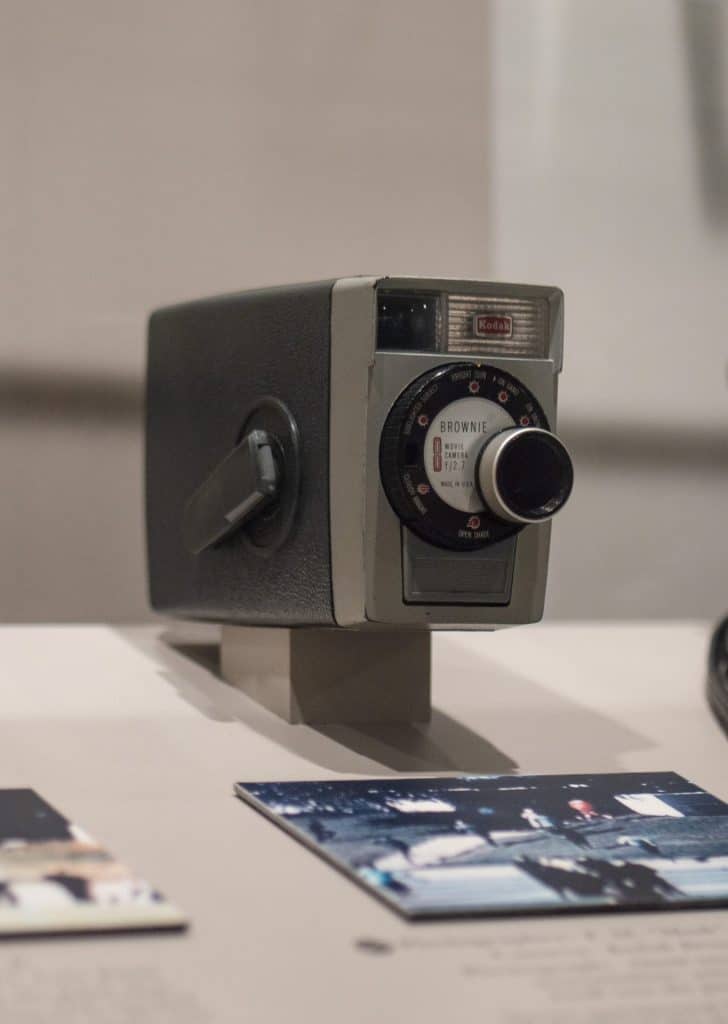
Bell Film (November 22, 1963) and Kodak Brownie 8 Camera
On November 22, 1963, Dallas mail carrier F.M. “Mark” Bell (1918–1998) brought his recently purchased single-lens Kodak Brownie 8 camera to work, promising his daughter, since Bell would not allow her to miss school that day, that he would take a home movie of President Kennedy for her. He captured approximately 15 seconds of the motorcade’s path through Dealey Plaza, tracing the route from Main Street, Houston Street, and turning onto Elm Street, where the President was shot. When he heard the gunfire, he moved to a different position and began filming again, capturing the assassination’s aftermath, including the President’s limousine speeding beneath the Triple Underpass and eyewitnesses hurriedly crossing Elm Street and running up the grassy knoll.
Mark Bell’s 8mm home movie was first featured in a 1967 issue of Life Magazine and in Josiah Thompson’s Six Seconds in Dallas (1967). The film was later examined by the House Select Committee on Assassinations in the late 1970s.
With the addition of the Bell film, the Museum holds a nearly complete photographic record of the Kennedy motorcade in Dealey Plaza, documenting through amateur home movies and photographs the turns from Main Street to Houston Street to Elm Street, the assassination and the limousine speeding beneath the Triple Underpass on its way to Parkland Memorial Hospital.
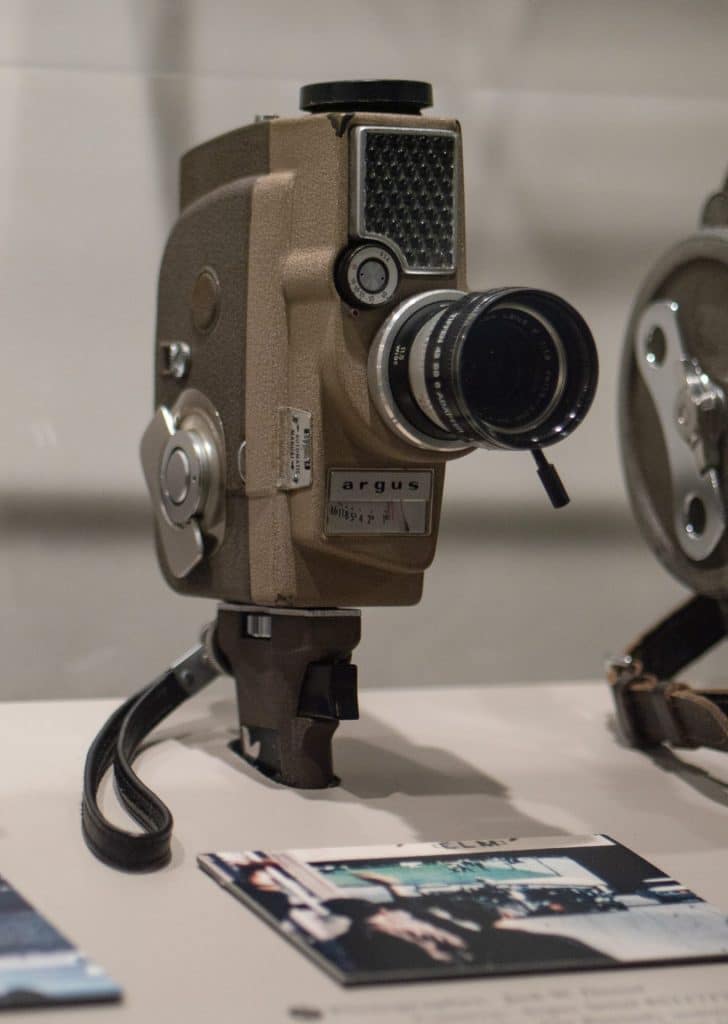
Jack Daniel Collection: Argus 8mm pistol-grip movie camera and footage of the assassination’s aftermath (November 22 and November 24, 1963)
The Museum’s newly acquired Jack Daniel Collection includes a significant 8mm color home movie taken by Dallas native Jack W. Daniel (1927-2015) in the immediate aftermath of the assassination on November 22, 1963. The frantic ten-second sequence, the only known home movie taken that day from the west side of the Triple Underpass, shows the presidential limousine speeding towards the Stemmons Freeway on-ramp while Daniel’s children, unaware of the tragedy in Dealey Plaza, vigorously wave at the accelerating vehicle.
The Collection also includes a subsequent home movie shot during Daniel’s return to the site on Sunday, November 24, 1963. In addition to documenting his position at the time of the assassination and the nearby Texas School Book Depository, Daniel captured excellent color footage of the flowers and tributes left by mourners in the days following President Kennedy’s death, a powerful historical example of a memorial practice that continues each year on the assassination anniversary.
Also acquired as part of the collection is Daniel’s 8mm pistol-grip movie camera, which was previously on long-term loan to The Sixth Floor Museum since 1996.
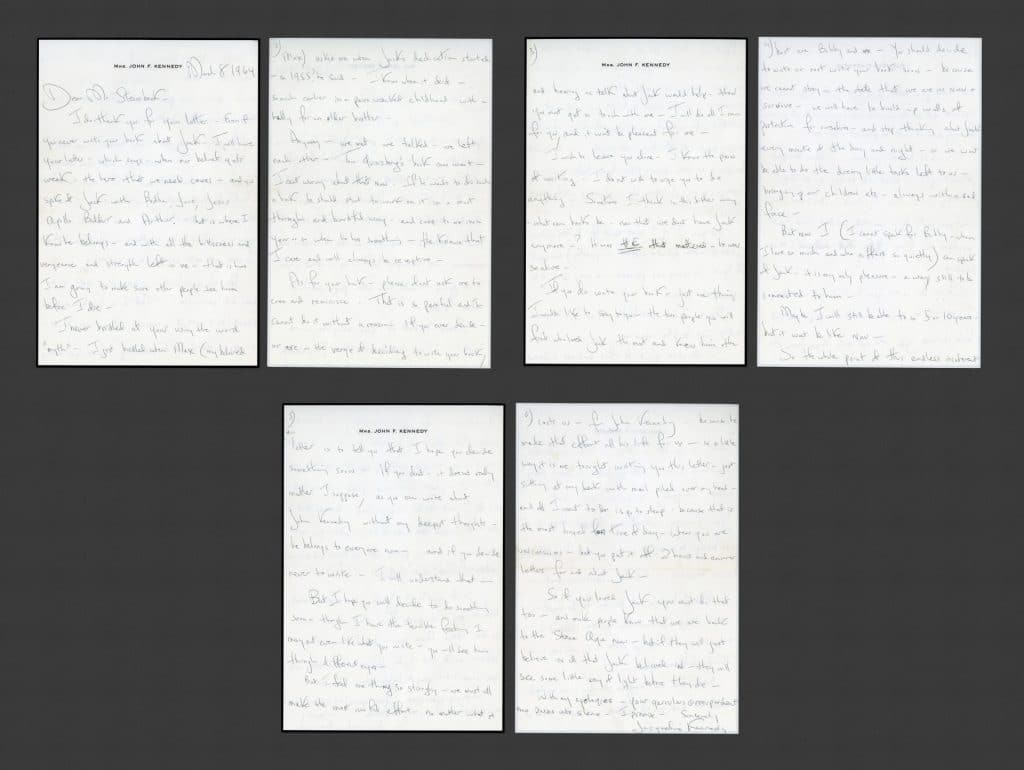
Two handwritten letters from Jacqueline Kennedy (1929–1994) to author John Steinbeck (1902– 1968), dated February 15 and March 8, 1964
Less than three months after the assassination, Jacqueline Kennedy implored Nobel Prize-winning author John Steinbeck (The Grapes of Wrath, Of Mice and Men) to write a definitive, authorized biography of her late husband. Steinbeck, who passed away in 1968, never wrote a book about President Kennedy. However, these letters provide a window into the mindset of Mrs. Kennedy shortly after the assassination and demonstrate her active desire to shape the narrative and legacy of her late husband’s life and presidency.
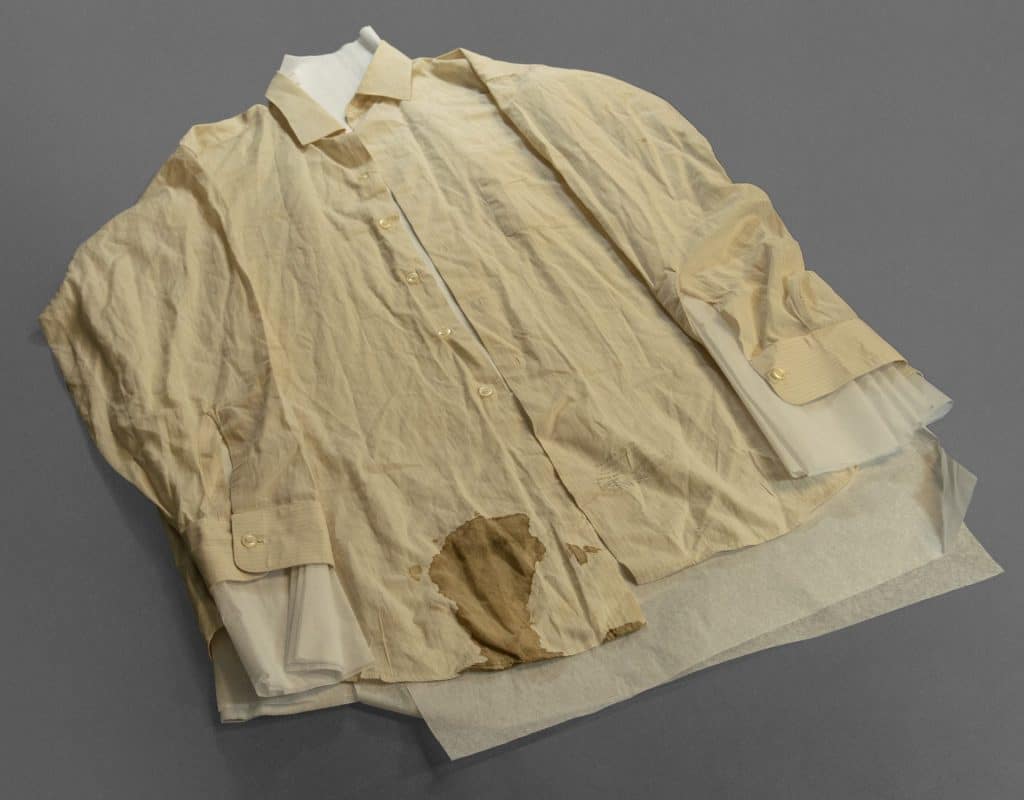
Shirt worn by Dr. Robert McClelland at Parkland Memorial Hospital on November 22, 1963
Dr. Robert McClelland (1929–2019), a surgeon and instructor at Parkland Memorial Hospital, was among the physicians inside Trauma Room One in Parkland’s Emergency Room during the resuscitation efforts for President Kennedy following the shooting. As Dr. McClelland recalled in a 2011 oral history, “When we took care of President Kennedy, I didn’t have time to change into scrubs, and I was… standing at the head of the gurney in my suit. And so, my suit was soaked in blood.” While his suit was later sent to the dry cleaners, he kept the dress shirt stained with the President’s blood. The shirt was donated to the Museum by Dr. McClelland’s family.
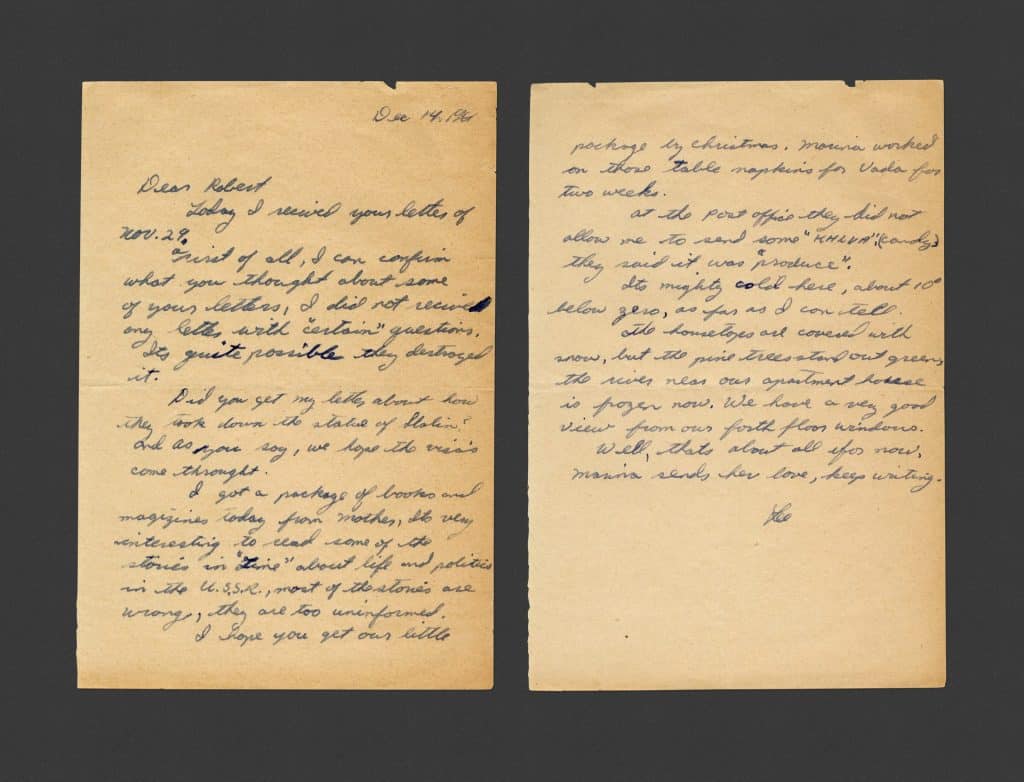
A handwritten letter from Lee Harvey Oswald to his brother, Robert Oswald, sent from Minsk, USSR (December 1961)
This December 1961 letter from Lee Harvey Oswald was sent to his brother, Robert Oswald, from Minsk USSR. In this two-page handwritten letter, Oswald criticizes Russian censorship for destroying his letters. Oswald writes “we hope the visas come through.” Researchers have questioned the supposed “ease” with which Lee and his wife, Marina, were able to leave the Soviet Union when, in reality, the couple ran into a year of bureaucratic hurdles. Here, in his own hand, Oswald expresses hope but uncertainty. He also complains about Soviet censorship and demonstrates his disillusionment with life, yet he is critical of American news coverage of the Soviets, noting that the news stories in Time magazine are “wrong” and “uninformed.” This letter illuminates Oswald’s mindset as he tried to return to the United States.
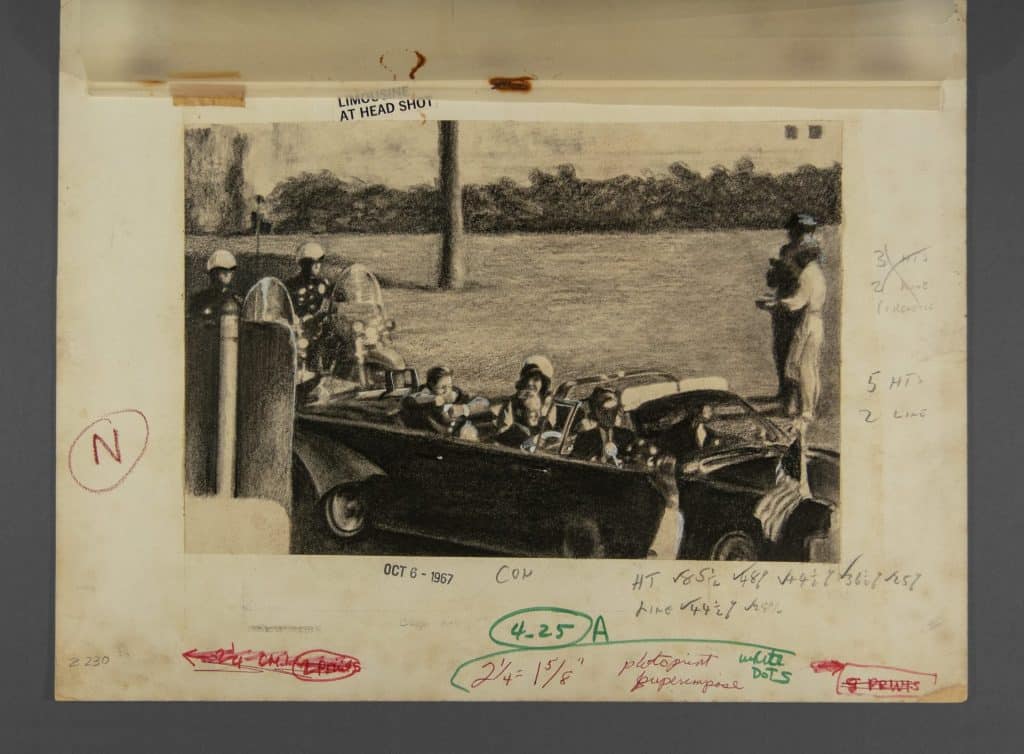
Charcoal drawings of Abraham Zapruder film frames, published in Six Seconds in Dallas (1967)
When assassination researcher Josiah Thompson was not permitted to publish frames from the Abraham Zapruder film in his landmark book, Six Seconds in Dallas (1967), he commissioned illustrator Arthur Hawkins to create a series of charcoal drawings of key frames for use in the book. The Josiah Thompson Collection includes 28 of these one-of-a-kind charcoal drawings, many retaining original handwritten editorial notations. Dr. Thompson donated these important drawings to the Museum.
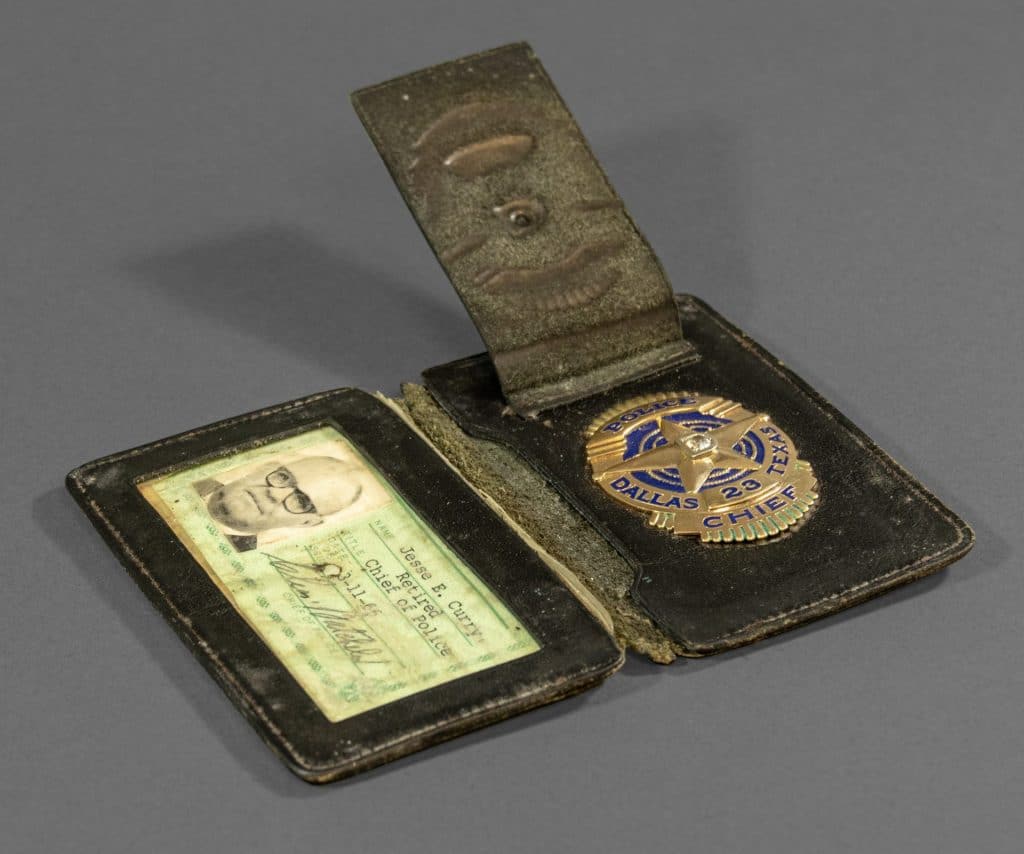
Jesse Curry Collection
Jesse Edward Curry (1913–1980) joined the Dallas Police Department in 1936 and served as Chief of Police from 1960 to 1966. He achieved international notoriety on November 22, 1963, as millions around the world watched him give televised interviews about the ongoing assassination investigation. Prior to the assassination, Chief Curry was actively involved in security preparations for the Kennedys’ visit to Dallas, and he drove the lead car in the motorcade, directly in front of the presidential limousine. Curry, who was present aboard Air Force One for the swearing-in of Lyndon Johnson that afternoon, remained heavily involved in the local investigation and later testified before the Warren Commission in 1964.
Donated by Jesse Curry’s son, Gene, the collection includes his late father’s Dallas Police Department badge and nametag, personal briefcase, and approximately 300 documents, including handwritten notes on the planning for the President’s trip to Dallas, police memos regarding the assassination investigation, and notes and research for Curry’s 1969 book, Retired Dallas Police Chief Jesse Curry Reveals his Personal JFK Assassination File.
Estate of Melvin Belli Collection
San Francisco attorney Melvin Belli (1907–1996) represented Jack Ruby in the shooting and killing of alleged presidential assassin Lee Harvey Oswald while he was being held in police custody. Belli initially argued that Ruby could not receive a fair trial in Dallas, and he helped characterize the city in a negative light on the world stage. After Ruby went on trial in Dallas, Belli told the jury that his client suffered from a rare type of epilepsy and was not aware of his actions when he shot Oswald. On March 14, 1964, Ruby was convicted of murder with malice and sentenced to death. Although the verdict was later overturned on appeal, the Ruby family fired Belli from the case immediately after the verdict was rendered.
The Estate of Melvin Belli Collection includes 150 linear feet of documents related to Melvin Belli’s defense of Jack Ruby, including correspondence received during the trial and after the verdict, internal correspondence among attorneys, administrative and financial files, and copies of briefs, manuscripts, and other documents relating to Belli’s work on the Ruby case.
ABOUT THE SIXTH FLOOR MUSEUM AT DEALEY PLAZA
The Sixth Floor Museum at Dealey Plaza is the only museum dedicated to the history of the assassination of President John F. Kennedy, a watershed moment that changed the course of American history. Located in the former Texas School Book Depository building in downtown Dallas, the Museum provides unparalleled insight into this generation-defining moment in the very place where the sniper’s perch was discovered, providing an authentic, powerful connection to the events of November 22, 1963, and those that surround it.
Located at 411 Elm Street in downtown Dallas, the Museum is open Wednesday–Sunday, 10 a.m. to 5 p.m. For more information, visit jfk.org or call 214.747.6660. Admission: $18 Adult, $16 Senior, $14 Youth (children aged 5 and under are free).
For more information, please contact:
Chelsea Beroza/Maria May/Kavita Oza
Resnicow and Associates, New York
Cberoza/Mmay/Koza@resnicow.com
212.671.5165 / 214.207.6082 / 212.671.5185

